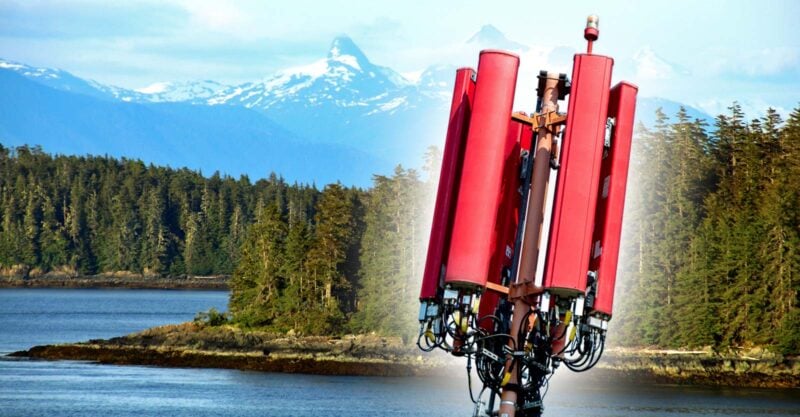Residents of Sitka, Alaska, with help from Children’s Health Defense’s Stop 5G initiative, are pulling out all the stops to prevent construction of the tower. They said they don’t need the services Tidal Network wants to provide, as they already have adequate wireless services through another company.
AUGUST 25, 2025
RSSREPUBLISH
PRINTSHARE
Listen to this article
6 min
Residents of Sitka, Alaska, with help from Children’s Health Defense’s (CHD) Stop 5G initiative, are doing all they can to prevent the construction of a 120-foot cell tower in their neighborhood.
The tower would be a “mere 145 feet” away from homes, “which is shockingly close,” Sitka residents Kelly Sweeney and Robert Krehbiel told The Defender in an email.
“It’s so close to my home, I could stand on my back porch and hit it with a rock,” said resident Hal Spackman.
After learning about the proposed tower, residents researched the risks of living in close proximity to cell towers and testified at an April 2 hearing before the city’s planning and zoning commission about why the tower was a bad idea.
The residents later formed Sitka for Safe Tech and sought legal help through CHD’s Stop 5G initiative.
Public opposition to the tower was so great that, initially, the project was defeated. However, Tidal Network, the wireless company that wants to build the tower, isn’t giving up.
Miriam Eckenfels, director of CHD’s Electromagnetic Radiation (EMR) & Wireless Program, said she is proud of the Sitka residents’ strong efforts to protect their neighborhood. “We know the fight might not be over and are prepared to fight alongside them as this battle continues.”
Cell tower would be in a landslide area
In February, Tidal Network asked the city for a variance to allow the company to erect the massive tower, even though the local code specifies a 35-foot maximum height restriction for such projects.
The company proposes to build the tower on a site that commonly experiences landslides.
After the city alerted residents living within 500 feet via a letter, Sitka for Safe Tech members researched the risks and wrote letters to the commission members.
According to the residents, the tower would have a negative visual impact on the neighborhood’s character, decrease property values and pose landslide risks.
Sitka is a remote island town of roughly 8,400 residents with spectacular scenery, wildlife and tight-knit neighborhoods.
The commission opted to delay voting on the issue until April 16 to give city staff time to enter all the testimony and discussion into the record. At the April 16 meeting, the commission unanimously denied the variance, signaling strong local opposition to Tidal Network’s plan.
However, Tidal Network on April 28 appealed the commission’s decision.
By city law, Sitka’s assembly would have been the authority to consider the appeal. However, at its May 29 meeting, when it was scheduled to hear the appeal, four of the six assembly members disclosed conflicts — including that they live in the neighborhood.
The assembly then directed the city to have the Alaska Office of Administrative Hearings hear the appeal. That meant that the decision would rest on the shoulders of a single judge.
On July 30, the residents filed a petition to intervene as parties in the appeal case before the state’s Office of Administrative Hearings, both as individuals who own property abutting the proposed tower site and as Sitka for Safe Tech.
Tidal Network argued in an Aug. 7 brief that the residents shouldn’t be allowed to intervene in the suit.
On Aug. 8, the judge ruled that the residents couldn’t join the suit as intervening parties, but that they could “submit a brief on relevant legal points and provide comment through counsel” at the appeal’s hearing on Aug. 21.
Sitka for Safe Tech submitted their brief on Aug. 14. W. Scott McCollough, lead litigator for CHD’s EMR & Wireless cases, spoke on their behalf at the Aug. 21 hearing.
McCollough said he thought the hearing went well. “We were able to get all our points across, especially on the safety risks and, in particular, how inappropriate this site is given demonstrated landslide risks.”
He added:
“This is not a slam dunk by any stretch. … But the bottom line is that the wireless company has to convince the judge to overturn each and every of the five findings by the planning commission.”
That won’t be easy, McCollough said.
The judge gave Tidal Network until Sept. 5 to respond to the residents’ points made through McCollough and their brief, and will decide by Sept. 12, according to McCollough.
Residents say tower isn’t needed
Tidal Network is run by the Central Council of the Tlingit & Haida Indian Tribes of Alaska.
According to a webpage about the council’s tribal enterprises, the telecom company “strives to connect communities and residents of Southeast Alaska by increasing access to broadband internet and providing training for digital literacy.”
Tidal Network contends the tower would improve internet and phone service.

This article was funded by critical thinkers like you.
The Defender is 100% reader-supported. No corporate sponsors. No paywalls. Our writers and editors rely on you to fund stories like this that mainstream media won’t write.
Sitka for Safe Tech says Sitka is already well-served by an existing provider, GCI, which provides affordable broadband and mobile service, including plans for $7.50/month for low-income residents.
Sitka for Safe Tech also opposes the tower because they believe it would set a “dangerous precedent” by allowing tall towers in a residential zone, Sweeney and Krehbiel said.
Sweeney and Krehbiel encouraged other communities to be proactive about seeking legal advice as soon as a tower is proposed.
Spackman agreed. “Contacting your local elected lawmakers and decision-makers at the first sign of a proposed tower increases the chances of successfully being able to protect your community from these harmful and unsightly towers.”
Spackman said that opposing this tower has placed a lot of mental stress and financial burden on the neighborhood’s residents. “It angers all of us at our cores. There are times our battle feels futile, but we are not giving up.”
The Central Council of the Tlingit & Haida Indian Tribes of Alaska did not immediately respond to a request for comment.Related articles in The Defender
- Alaskans Join Forces With CHD to Fight Giant Cell Tower in Residential Area
- Residents in Small Nevada Town Step Up Fight Against Verizon’s Plan to Build Cell Tower Near School, Homes
- ‘No Place in Our Community’: Santa Cruz Residents Sue County Over AT&T Cell Tower
- Residents of Hawaii’s Big Island Pass Law to Keep Cell Towers Away from Homes, Schools
- A Win for Walla Walla: Residents Beat Back AT&T Plan to Build Cell Tower Near Homes, School

Suzanne Burdick, Ph.D.
Suzanne Burdick, Ph.D., is a reporter and researcher for The Defender based in Fairfield, Iowa
Click this link for the original source of this article.
Author: brianpeckford
This content is courtesy of, and owned and copyrighted by, https://peckford42.wordpress.com and its author. This content is made available by use of the public RSS feed offered by the host site and is used for educational purposes only. If you are the author or represent the host site and would like this content removed now and in the future, please contact USSANews.com using the email address in the Contact page found in the website menu.





